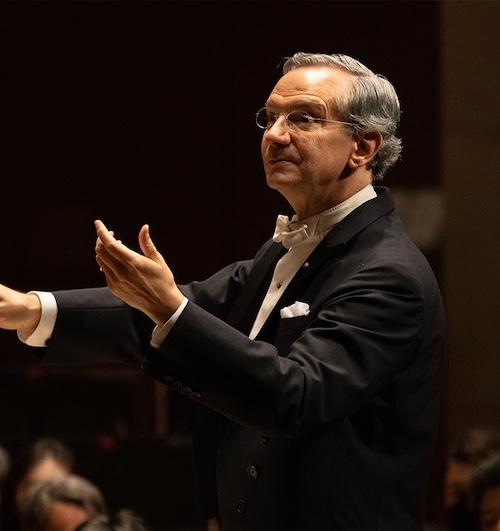Luisi, DSO unseal the Apocalypse with powerful Schmidt rarity

The Book of the Seven Seals was finally opened at Morton Meyerson Symphony Hall Friday night.
Originally scheduled for 2020, Franz Schmidt’s sprawling oratorio, Das Buch mit sieben Siegeln, fell victim to the Covid-19 pandemic. Rescheduled for this weekend, Fabio Luisi led the Dallas Symphony Orchestra and Chorus and six soloists in the epic work Friday night.
Schmidt’s oratorio, completed in 1937, is based on the Book of Revelation He sets passages in two large parts describing the appearance of Jesus as the Lamb of God, the opening of the book with seven seals and the calamities that follow —war in heaven and on earth. Ultimately, the angels and the disciples of Jesus defeat Satan and his followers, which heralds the creation of a new heaven, earth and Jerusalem.
Although the work premiered during the 1930s, it is steeped in the post-romantic sound of music composed some three to four decades earlier, evoking the music of Bruckner, Mahler and even Brahms.
Following a prologue introduced by John the Evangelist (tenor Paul Appleby), who has been called by the Voice of the Lord (bass Franz-Josef Selig) to witness a vision of events to come. These events proceed as a series of musical episodes, most of which are announced by a brief recitative from the Evangelist.
The successive episodes feature an abundance of descriptive music, most of which draws on post-romantic conventions of harmony, gesture and recurring motifs associated with ideas in the text.
That said, there are passages that are notable for their striking illustrative effects. Mont notable is the music following the announcement of the fourth seal, with its clipped xylophone chords and col legno strings over a desolate harmonic background, all of which suggests a field of bones brought on by the rider of the pale horse.
The second episode, depicting the opening of the second seal and the rider of the red horse, was unmatched for sheer sound and fury. Brutal and relentless martial rhythms punctuated by tam-tam crashes accompany calls for war and murder by the men’s chorus.
While the oratorio’s subject might prompt the audience to expect a preoccupation with horror in the music and text, there is an equal measure of blissful music ranging from calmly pastoral to openly joyous.
Nowhere is this more evident than in the “Hallelujah” movement coming toward the end of the piece. In response to the Voice of the Lord declaring that he will dwell with his people in the new Jerusalem, the entire ensemble embarks on a series of choral exhortations that build to a climax. Notably, the sentiment is quite different from the jubilation typically associated with the “Hallelujah” chorus from Handel’s Messiah. Here, the chorus embodies a serenity that goes beyond jubilation and achieves transcendence, a goal and sensibility that further links Schmidt’s piece with his earlier, post-romantic forebears.
The superb performance by the orchestra, the chorus and the soloists succeeded in realizing the full power of Das Buch.
As the Evangelist, Paul Appleby led listeners assuredly through John’s visions while Franz-Josef Selig gave stern yet compassionate authority to the Voice of the Lord.
Meghan Kasanders and Kelley O’Connor were particularly effective in their poignant dialogue between a starving mother and daughter following the arrival of the black horse stemming from the third seal. Similarly, Hadleigh Adams and Matthew Pearce gave an especially sobering duet as two battlefield comrades surveying the plain of death unleashed by the fourth seal.
In addition to his supporting role, organist Bradley Welch led off each of the two parts with a compelling organ prelude built on a fugal setting of the mysterious theme for the book of seals itself.
Somewhat surprisingly, the climactic chorus of “Hallelujah” discussed above was not the actual end. Two short movements followed: a brief expression of thanksgiving by the men’s chorus in the style of plainchant and a reprise of the opening fanfare from the Prologue during which the Evangelist attests to his vision and gives his blessing. These two closing movements provided structural symmetry and a tranquil epilogue to the whole, and by evoking the transcendence of heard in “Hallelujah” in the closing “Amen,” the final movement captured the oratorio’s mix of power, glory and comfort intended in John the Evangelist’s message.
The Book with Seven Seals will be repeated 3 p.m. Sunday. dallassymphony.org
William McGinney is an adjunct professor of musicology at Texas Christian University. He has worked for a manufacturer and paper merchant, given presentations and published on Aaron Copland, Emerson, Lake & Palmer, and music of dystopian science fiction films. He also played keyboards for a short-lived progressive rock band in Austin and has written scores for independent films.